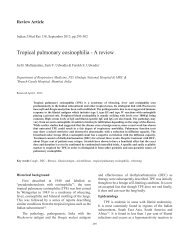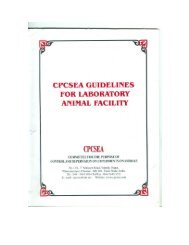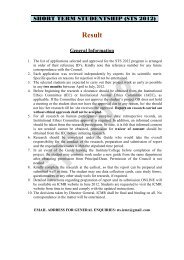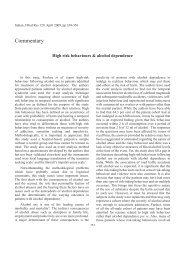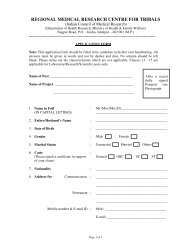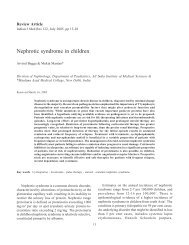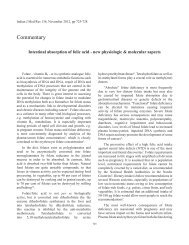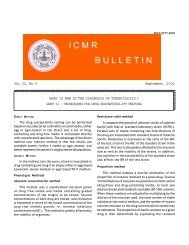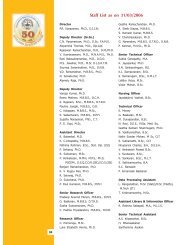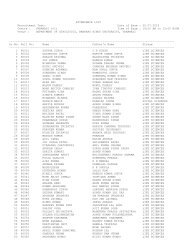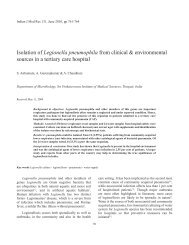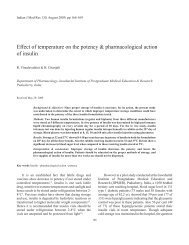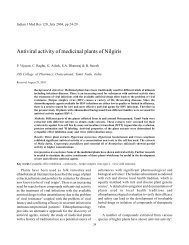Azadirachta indica - Indian Council of Medical Research
Azadirachta indica - Indian Council of Medical Research
Azadirachta indica - Indian Council of Medical Research
Create successful ePaper yourself
Turn your PDF publications into a flip-book with our unique Google optimized e-Paper software.
<strong>Indian</strong> J Med Res 130, August 2009, pp 112-114<br />
Commentary<br />
<strong>Azadirachta</strong> <strong>indica</strong> as a public health tool for the control <strong>of</strong> malaria &<br />
other vector-borne diseases<br />
Neem-basedproductsfrom<strong>Azadirachta</strong> <strong>indica</strong>have<br />
been successfully used for pest control in agriculture<br />
and gardening since long in India and more recently in<br />
European countries and in the USA 1 . The seed kernels,<br />
particularly rich in bioactive azadirachtin and other<br />
limonoids (tetranortriterpenoids), are the main source<br />
for a large number <strong>of</strong> products used for the control <strong>of</strong><br />
pest insects, mites, fungi and soil-borne nematodic root<br />
parasites 1 .<br />
Surprisingly, registered neem products for the<br />
control <strong>of</strong> pathogens, ectoparasites or disease vectors<br />
affecting human and animal health are few. The<br />
moderate interest <strong>of</strong> chemical and pharmaceutical<br />
industries for developing neem-based products for<br />
human health stands in sharp contrast to the wide<br />
traditional use <strong>of</strong> neem preparations by populations <strong>of</strong><br />
different cultures, in India, in other Asian countries and<br />
in Africa. Leaves, seeds, roots, bark and the flowers <strong>of</strong><br />
the plant are used to cure different ailments, such as<br />
jaundice and stomach ulcers and to combat a variety <strong>of</strong><br />
infectious and parasitic diseases, ranging from leprosy,<br />
to chicken pox, to malaria 2 .<br />
A large amount <strong>of</strong> scientific evidence is available<br />
on the potential <strong>of</strong> A. <strong>indica</strong> as a source for the<br />
development <strong>of</strong> human and animal health products.<br />
For example, neem seed oil and essential oils from<br />
leaves and bark have been shown to inhibit the<br />
growth <strong>of</strong> various genera <strong>of</strong> pathogenic bacteria,<br />
such as Mycobacterium and Streptococcus 3 . Antiviral<br />
activity <strong>of</strong> neem leaf extracts has been evidenced<br />
against dengue virus 4 and HIV 5 . Moreover, several<br />
important parasitic protozoa, including Trypanosoma 6 ,<br />
Leishmania 7 and Plasmodium 8 , have been shown to be<br />
susceptible to neem extracts and purified limonoids.<br />
Antifilarial activity has been demonstrated with an<br />
alcoholic extract <strong>of</strong> neem flowers against Setaria cervi,<br />
a parasitic nematode <strong>of</strong> the water buffalo (Bubalis<br />
112<br />
bubalis) 9 . Further, many arthropod ectoparasites are<br />
susceptible to both the insecticidal, growth regulatory<br />
and repellent activity <strong>of</strong> neem extracts 10 : for example,<br />
lice 11 and ticks 12 can be successfully controlled by neem<br />
extracts, and many species <strong>of</strong> mosquitoes, including<br />
important vectors <strong>of</strong> parasitic diseases, have been<br />
shown to be susceptible to neem products 13 .<br />
In this issue, K. Gunasekaran and colleagues 14<br />
present evidence on the potential <strong>of</strong> the commercial<br />
product NeemAzal T/S 1.2 per cent EC for the control<br />
<strong>of</strong> Anopheles stephensi, Culex quinquefasciatus and<br />
Aedes aegypti, vectors <strong>of</strong> important infectious and<br />
parasitic diseases. Less than 1 ppm <strong>of</strong> the product,<br />
added to larval basins, was adequate to interfere with<br />
larval development, inhibiting the emergence <strong>of</strong> adults<br />
by 50 per cent. Thus, NeemAzal T/S 1.2 per cent EC can<br />
be considered a promising insecticide to complement<br />
currently used biological larvae control tools, such<br />
as Bacillus thuringiensis var. israelensis and B.<br />
sphaericus formulations, insect growth regulators and<br />
larvivourous fish 15 . As neem trees are very common in<br />
most countries with mosquito-borne diseases, neem<br />
based larvicides can be produced locally. In areas<br />
where commercial larvicides are not accessible or not<br />
affordable to the population, the local preparation <strong>of</strong><br />
neem extracts or the use <strong>of</strong> unprocessed plant parts like<br />
crushed seeds or wood chippings may represent a valid<br />
alternative. Evidence supporting such a communitybased<br />
approach has been recently published by<br />
scientists from a Kenyan research institution, showing<br />
that neem wood chippings added at 0.4 g/l to water<br />
basins containing An. gambiae s.s. larvae inhibited<br />
adult emergence by 50 per cent 16 .<br />
Currently, malaria control strategies in endemic<br />
areas focus on vector control targeted to the adult<br />
mosquito stage. In several African countries, the<br />
intensity <strong>of</strong> transmission and the disease burden have
HABLUETzEL et al: A. iNdiCA AS A PUBLIC HEALTH TOOL FOR MALARIA & OTHER VECTOR-BORNE DISEASES 113<br />
been successfully reduced by the wide use <strong>of</strong> insecticide<br />
treated bed nets (ITN) and indoor residual spraying<br />
(IRS) 17 . Targeting adults has the advantage that, under<br />
sufficient coverage conditions, an impact not only on<br />
mosquito densities but also on mosquito longevity<br />
is achieved, resulting in a reduction in the number<br />
<strong>of</strong> infective mosquitoes. The recent encouraging<br />
results have raised renewed confidence that malaria<br />
elimination or at least a major reduction <strong>of</strong> transmission<br />
is feasible, even in African settings. To reach this goal,<br />
however, integrated vector control needs to be adopted<br />
as a strategy, supplementing ITN and IRS with larval<br />
control measures tailored to the eco-epidemiological<br />
settings. Larviciding is suitable for urban and peri-urban<br />
areas, where permanent and semi-permanent breeding<br />
sites are identifiable, and has a potential also in settings<br />
characterized by a markedly seasonal vector activity,<br />
where it allows the transmission season to be shortened<br />
by treating breeding sites15 . Biological larvicides, such<br />
as neem based products, have a valuable role to play in<br />
such integrated vector control endeavours.<br />
The insecticides <strong>of</strong> choice for treating bednets<br />
and mosquito netting are synthetic pyrethroids such<br />
as permethrin, deltamethrin and alpha-cypermethrin.<br />
However, the emergence <strong>of</strong> pyrethroid-resistant vector<br />
species in many endemic areas and the threat <strong>of</strong> losing<br />
these effective insecticides for malaria control, urge<br />
for the development <strong>of</strong> alternatives. May <strong>Azadirachta</strong><br />
<strong>indica</strong> be a potential resource for the development <strong>of</strong><br />
new insecticides for the treatment <strong>of</strong> netting or housing?<br />
Neem based insecticides act on target organisms mainly<br />
after oral uptake. However, contact activity has been<br />
described in some species. For example, the topical<br />
application <strong>of</strong> neem oil or azadirachtin rich neem<br />
seed kernel extract on Glossina specimens, reduced<br />
fecundity and survival <strong>of</strong> the treated females18 and<br />
exposure <strong>of</strong> An. stephensi and An. culicifacies females<br />
to volatile neem compounds was found to impair<br />
vitellogenesis19 . On the basis <strong>of</strong> these evidences, studies<br />
aimed at elucidating absorption mechanisms <strong>of</strong> neem<br />
molecules trough the cuticle <strong>of</strong> adult mosquitoes and at<br />
identifying bioactive compounds acting on mosquito<br />
tissues should be encouraged and may help to pave the<br />
way to the development <strong>of</strong> neem based adulticides.<br />
The use <strong>of</strong> neem to combat mosquito nuisance<br />
makes part <strong>of</strong> the traditional knowledge ‘backpack’<br />
<strong>of</strong> many Asian and African populations. Studies are<br />
now available that confirm the repellent efficacy <strong>of</strong><br />
neem oil when applied on exposed skin parts20 and<br />
that support the use <strong>of</strong> neem oil in kerosene lamps<br />
to expel blood seeking mosquitoes from houses 21 . A<br />
recent entomological study conducted in experimental<br />
houses in an area <strong>of</strong> Tanzania shows that the traditional<br />
custom <strong>of</strong> burning <strong>Azadirachta</strong> leaves and other plant<br />
species (e.g., Ocimum sps.) reduces human biting and<br />
indoor resting <strong>of</strong> mosquitoes 22 . Such validation studies<br />
on traditional vector and disease control measures<br />
should be encouraged to provide a rational basis for<br />
integrated disease control, ‘integrated’ not only in<br />
terms <strong>of</strong> combining different measures but also in terms<br />
<strong>of</strong> exploiting both, modern science and traditional<br />
medicine knowledge.<br />
A. Habluetzel * , L. Lucantoni & F. Esposito<br />
Department <strong>of</strong> Experimental Medicine & Public Health<br />
University <strong>of</strong> Camerino<br />
62032 Camerino (MC), Italy<br />
* For correspondence:<br />
annette.habluetzel@unicam.it<br />
References<br />
1. Neem Foundation. Abstract book - World Neem Conference;<br />
November 21-24, 2007; Coimbatore, India. Mumbai: Neem<br />
Foundation; 2007.<br />
2. National <strong>Research</strong> <strong>Council</strong> (US). Board on Science and<br />
Technology for International Development. Neem: a tree for<br />
solving global problems. Washington, DC: National Academy<br />
Press; 1992.<br />
3. Biswas K, Chattopadhyay I, Banerjee RK, Bandyopadhyay<br />
U. Biological activities and medicinal properties <strong>of</strong> neem<br />
(<strong>Azadirachta</strong> <strong>indica</strong>). Curr Sci 2002; 82 : 1336-45.<br />
4. Parida MM, Upadhyay C, Pandya G, Jana AM. Inhibitory<br />
potential <strong>of</strong> neem (<strong>Azadirachta</strong> <strong>indica</strong> Juss) leaves on dengue<br />
virus type-2 replication. J Ethnopharmacol 2002; 79 : 273-8.<br />
5. Udeinya IJ, Mbah AU, Chijioke CP, Shu EN. An antimalarial<br />
extract from neem leaves is antiretroviral. Trans R Soc Trop<br />
Med Hyg 2004; 98 : 435-7.<br />
6. Yanes A, Finol HJ, Hasegawa M. Effects <strong>of</strong> <strong>Azadirachta</strong><br />
<strong>indica</strong> and Melia azedarach (Meliaceae) extracts from leaves<br />
on Trypanosoma cruzi growth and ultrastructure. J Submicrosc<br />
Cytol Pathol 2004; 36 : 149-54.<br />
7. El Tahir A, Ibrahim AM, Satti GMH, Theander TG, Kharazmi<br />
A, Khalid AS. The potential antileishmanial activity <strong>of</strong> some<br />
Sudanese medicinal plants. Phytother Res 1998; 12 : 576-9.<br />
8. Udeinya JI, Shu EN, Quakyi I, Ajayi FO. An antimalarial<br />
neem leaf extract has both schizonticidal and gametocytocidal<br />
activities. Am J Ther 2008; 15 : 108-10.<br />
9. Mishra V, Parveen N, Singhal KC, Khan NU. Antifilarial<br />
activity <strong>of</strong> <strong>Azadirachta</strong> <strong>indica</strong> on cattle filarial parasite Setaria<br />
cervi. Fitoterapia 2005; 76 : 54-61.<br />
10. Mulla MS, Su T. Activity and biological effects <strong>of</strong> neem<br />
products against arthropods <strong>of</strong> medical and veterinary<br />
11.<br />
importance. J Am Mosq Control Assoc 1999; 15 : 133-52.<br />
Habluetzel A, Carnevali F, Lucantoni L, Grana L, Attili AR,<br />
Archilei F, et al. Impact <strong>of</strong> the botanical insecticide Neem
114 INDIAN J MED RES, AUGUST 2009<br />
Azal(r) on survival and reproduction <strong>of</strong> the biting louse<br />
damalinia limbata on angora goats. Vet Parasitol 2007; 144 :<br />
328-37.<br />
12. Garboui SS, Jaenson TG, Palsson K. Repellency <strong>of</strong> MyggA<br />
natural spray (para-menthane-3,8-diol) and RB86 (neem oil)<br />
against the tick ixodes ricinus (Acari: Ixodidae) in the field in<br />
east-central Sweden. Exp Appl Acarol 2006; 40 : 271-7.<br />
13. Lucantoni L, Giusti F, Crist<strong>of</strong>aro M, Pasqualini L, Esposito<br />
F, Lupetti P, et al. Effects <strong>of</strong> a neem extract on blood feeding,<br />
oviposition and oocyte ultrastructure in Anopheles stephensi<br />
Liston (Diptera: Culicidae). Tissue Cell 2006; 38 : 361-71.<br />
14. Gunasekaran K, Vijayakumar T, Kalyanasundaram M.<br />
Larvicidal & emergence inhibitory activities <strong>of</strong> NeemAzal<br />
T/S 1.2 per cent EC against vectors <strong>of</strong> malaria, filariasis &<br />
dengue. indian J Med Res 2009; 130 : 138-45.<br />
15. Walker K, Lynch M. Contributions <strong>of</strong> Anopheles larval<br />
control to malaria suppression in tropical Africa: review <strong>of</strong><br />
achievements and potential. Med Vet Entomol 2007; 21 : 2-<br />
21.<br />
16. Howard AF, Adongo EA, Hassanali A, Omlin FX, Wanjoya<br />
A, zhou G, et al. Laboratory evaluation <strong>of</strong> the aqueous extract<br />
<strong>of</strong> <strong>Azadirachta</strong> <strong>indica</strong> (neem) wood chippings on Anopheles<br />
gambiae s.s. (Diptera: Culicidae) mosquitoes. J Med Entomol<br />
2009; 46 : 107-14.<br />
17. World Health Organization. World malaria report 2008.<br />
WHO/HTM/GMP/2008.1; 2008. p. 1-190.<br />
18. Wilps H. Diptera: mosquitoes and flies. In: Schmutterer H,<br />
editor. The neem tree <strong>Azadirachta</strong> <strong>indica</strong> A Juss and other<br />
meliaceous plants: sources <strong>of</strong> unique natural products for<br />
integrated pest management, medicine, industry and other<br />
purposes. Weinheim: VCH; 1995. p. 318-26.<br />
19. Dhar R, Dawar H, Garg S, Basir SF, Talwar GP. Effect <strong>of</strong><br />
volatiles from neem and other natural products on gonotrophic<br />
cycle and oviposition <strong>of</strong> Anopheles stephensi and An.<br />
culicifacies (Diptera: Culicidae). J Med Entomol 1996; 33 :<br />
195-201.<br />
20. Dua VK, Nagpal BN, Sharma VP. Repellent action <strong>of</strong> neem<br />
cream against mosquitoes. indian J Malariol 1995; 32 : 47-<br />
53.<br />
21. Ansari MA, Razdan RK. Operational feasibility <strong>of</strong> malaria<br />
control by burning neem oil in kerosene lamp in BeelAkbarpur<br />
village, District Ghaziabad, India. indian J Malariol 1996; 33<br />
: 81-7.<br />
22. Kweka EJ, Mosha FW, Lowassa A, Mahande AM, Mahande<br />
MJ, Massenga CP, et al. Longitudinal evaluation <strong>of</strong> Ocimum<br />
and other plants effects on the feeding behavioral response<br />
<strong>of</strong> mosquitoes (Diptera: Culicidae) in the field in Tanzania.<br />
Parasit Vectors 2008; 1 : 42.



